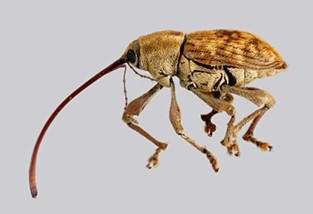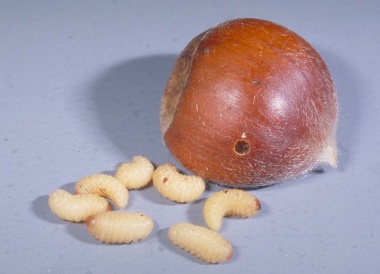The Battle of the Chestnut Weevil
by Elaine Pugh, Fairfax County Master Gardener
The American Chestnut Foundation is currently working with the State University of New York’s College of Environmental Science and Forestry to develop a blight resistant American chestnut tree. There has recently been a call for people to plant American chestnut seedlings and then later plant the tolerant variety so they can cross pollinate and ultimately restore the species to its native range, which includes Virginia.
Castanea dentata, the native American Chestnut tree, known for its healthy nuts and strong lumber, was attacked by the Chestnut Blight fungus, Cryphonectria parasitica, in the early 1900’s. By the 1960’s, it had almost completely wiped out the American Chestnut tree population. Most chestnut growers in Virginia today have Castanea mollissima, the Chinese Chestnut tree, or a related hybrid.

Lesser chestnut weevil
Despite the loss of literally billions of American Chestnut trees over the years, somehow the native pests have survived. If you are going to participate and plant these trees, which is a good cause, you should be aware of them.
Curculio sayi, the Lesser Chestnut Weevil, and Curculio caryatrypes, the Greater Chestnut Weevil, are the most damaging pests and only attack chestnut trees. Both of these can be found in Virginia. These pests have larvae — legless grubs, worms — that attack the nuts from within and, although they do not appear to harm the tree, they can destroy the nut harvest. The Lesser Chestnut Weevil is the most prevalent.
I have two mature chestnut trees in my backyard, and I have never seen an adult chestnut weevil, but I have them. According to the U.S. Dept. of Agriculture, you can tell which one you have by the diameter of the round hole that the larvae bores through the chestnut hull. The holes vary in diameter from 1/16 of an inch, in the case of the smaller Lesser Chestnut Weevil, to 1/8 of an inch in the larger Greater Chestnut Weevil.
Lifecycle
Lesser Chestnut Weevils are tan or dark brown and just 1/4 of an inch in length with a pin-like snout of equal or greater length. They emerge from the ground in late May through July, about when the chestnuts bloom. They feed on the foliage and lay eggs in the fall after the burr in the chestnut pod begins to open. The female weevil uses her long proboscis to drill a hole into the inner lining of the shell and lays her eggs. Eggs hatch in about 10 days, and larval development is completed within the nut two to three weeks later.

Greater chestnut weevil
The Lesser Chestnut Weevil larvae develop in the chestnut shell until the chestnuts mature around Labor Day in September, and they start falling off the tree in prickly pods with about three chestnuts each. If left on the ground, the larvae will eat holes through the nuts and burrow into the ground. Most of the Lesser Chestnut Weevil larvae remain in the soil for two to three years before re-emerging as adults to restart the cycle.
The Greater Chestnut Weevil is the same color but longer at 1/3 to 1/2 of an inch in length with a pin-like snout of equal or greater length. The damage is the same but the lifecycle is different from the Lesser Chestnut Weevil. It emerges in late July and August and begins laying eggs soon after emerging. The larvae also usually drop to the ground before the nuts fall, and their life cycle is completed in just one to two years.
Management
For chestnut weevil control, management is the same for both weevils. The best way to stop the cycle is to remove the mature spikey chestnut nut pods every day (with an extension grabber) when the pods start falling off the tree around Labor Day in September. This is before the larvae can leave the nuts and burrow back into the ground. This is easier said than done because squirrels absolutely love them and are fast runners.

Chestnut weevil larvae
Vegetation should be limited around the tree so you can find the chestnut pods easily. Purdue University suggests bare ground or closely mowed grass beneath the trees. Virginia Tech suggests mulching around the tree with the added benefit of increasing tree growth and productivity.
According to Virginia Tech, synthetic or organic pesticides can also be applied to control for weevils. “Pyrethrin, a primary compound in Pyganic, is a useful organic control. The registered synthetic insecticide, Sevin, can also be applied for four weeks straight starting in late July.”
According to the USDA, the weevils do have one natural enemy — a small four-winged wasplike fly, the Braconid parasite Urosigalphus armatus Ashm., which develops in the body of the larvae.
For the nuts themselves, it’s a hands-on approach. After carefully removing the chestnuts from the spikey pods, Virginia Tech recommends placing harvested chestnuts immediately into a hot water bath at 118 F to kill any weevil larvae. As an option, Purdue University recommends heating the nuts in the oven to 120 F for 20 to 30 minutes to kill larvae in the nuts. Heating in the oven works. I haven’t tried a hot water bath yet. However, timing is important. I once left the nuts in a bucket for a few days and found a lot of wriggly larvae at the bottom when I returned. The nut flesh was ruined, and at that point the nuts needed to be discarded. The extra attention is worth the effort. Chestnuts with Brussel sprouts. Chestnut bread. Chestnuts just eaten as a snack. Etc.
In the movie Master and Commander, there were two weevil larvae on a plate, and the joke was that the difference between the two was that one was the lesser of two (we)evils. Chestnut trees can indeed get the greater or lesser of two (we)evils.
Conclusion
The reforestation efforts for the American Chestnut tree are up and running. So are the pests.
I hope this helps.
References
• Commercial Chinese Chestnut Production in Virginia, Katie E. Commender, John F. Munsell and
Adrian Ares, Virginia Cooperative Extension
• The Nut Weevils, F. H. Chittenden, U.S. Department of Agriculture
• Nut Weevils, Ric Bessin, University of Kentucky
• Chestnut Weevils, Bruce Bordelon, Department of Horticulture and Landscape Architecture, Purdue
University
• Chestnut weevil: A potential pest of Michigan chestnuts, Erin Lizotte, Michigan State University
Extension